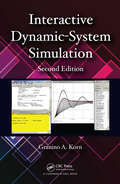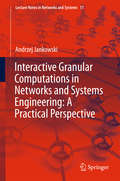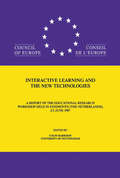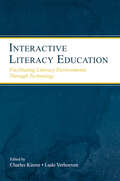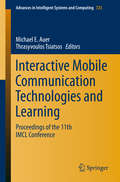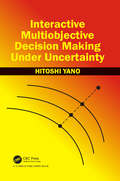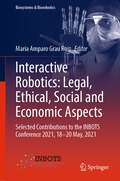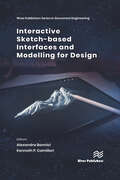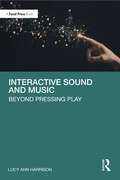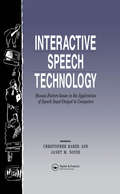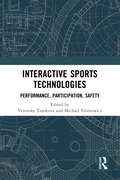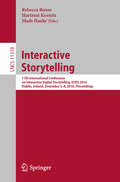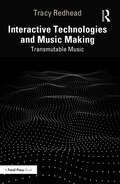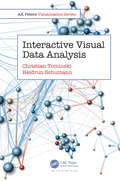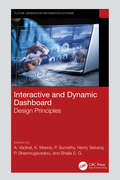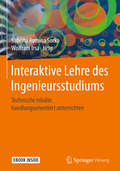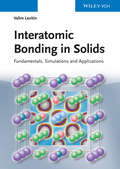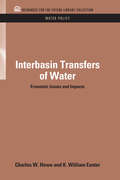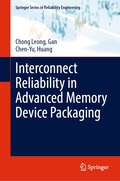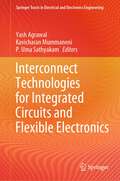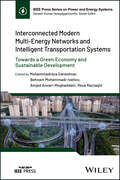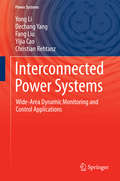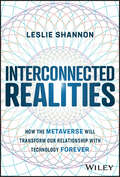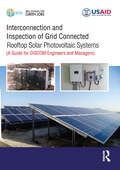- Table View
- List View
Interactive Dynamic-System Simulation (Numerical Insights)
by Granino A. KornShowing you how to use personal computers for modeling and simulation, Interactive Dynamic-System Simulation, Second Edition provides a practical tutorial on interactive dynamic-system modeling and simulation. It discusses how to effectively simulate dynamical systems, such as aerospace vehicles, power plants, chemical processes, control systems, and physiological systems.Written by a pioneer in simulation, the book introduces dynamic-system models and explains how software for solving differential equations works. After demonstrating real simulation programs with simple examples, the author integrates a new treatment of the difference equation programs needed to model sampled-data control systems with digital controllers. Subsequent chapters provide detailed programming know-how. These chapters cover library, table-lookup, user-definable, limiter, switching, and noise functions; an experiment-protocol scripting language; powerful vector and matrix operations; and classical simulation programs that illustrate a number of useful programming tricks. The final chapter shows how experiment-protocol scripts and compiled DYNAMIC program segments can quickly solve mathematical problems, including fast graph plotting, Fourier transforms, and complex-number plots.Downloadable ResourcesThe accompanying downloadable resources contain a complete, industrial-strength simulation program package. To install the ready-to-run simulation system, simply copy a single Windows or Linux folder from the downloadable resources. You can then run and modify every program example in the text or try your own projects. For truly interactive modeling, screen-edited programs are run-time compiled and immediately produce solution displays on a typed run command.
Interactive Granular Computations in Networks and Systems Engineering: A Practical Perspective
by Andrzej JankowskiThe book outlines selected projects conducted under the supervision of the author. Moreover, it discusses significant relations between Interactive Granular Computing (IGrC) and numerous dynamically developing scientific domains worldwide, along with features characteristic of the author's approach to IGrC. The results presented are a continuation and elaboration of various aspects of Wisdom Technology, initiated and developed in cooperation with Professor Andrzej Skowron. Based on the empirical findings from these projects, the author explores the following areas: (a) understanding the causes of the theory and practice gap problem (TPGP) in complex systems engineering (CSE); (b) generalizing computing models of complex adaptive systems (CAS) (in particular, natural computing models) by constructing an interactive granular computing (IGrC) model of networks of interrelated interacting complex granules (c-granules), belonging to a single agent and/or to a group of agents; (c) developing methodologies based on the IGrC model to minimize the negative consequences of the TPGP. The book introduces approaches to the above issues, using the proposed IGrC model. In particular, the IGrC model refers to the key mechanisms used to control the processes related to the implementation of CSE projects. One of the main aims was to develop a mechanism of IGrC control over computations that model a project's implementation processes to maximize the chances of its success, while at the same time minimizing the emerging risks. In this regard, the IGrC control is usually performed by means of properly selected and enforced (among project participants) project principles. These principles constitute examples of c-granules, expressed by complex vague concepts (represented by c-granules too). The c-granules evolve with time (in particular, the meaning of the concepts is also subject of change). This methodology is illustrated using project principles applied by the author during the implementation of the POLTAX, AlgoTradix, Merix, and Excavio projects outlined in the book.
Interactive Learning & The New
by Colin HarrisonThis book compares research findings on particular topic of interactive learning to identify areas of research, and discusses possibilities of research co-operation. It presents an argument that in the UK the emphasis on small group work using a microcomputer is the result of pedagogical opinion.
Interactive Literacy Education: Facilitating Literacy Environments Through Technology
by Ludo Verhoeven Charles KinzerInteractive Literacy Education combines the latest research and theory related to technology-based instructional design for children’s literacy development. It shows how technology can be used to build literacy learning environments that are compatible with students’ cognitive and social processes. Topics addressed throughout this enlightening work include:*technology environments and applications that preservice teachers can use with young children;*detailed information regarding the development and implementation of specific technological programs; and*various technologies, from interactive reading and spelling programs to speech recognition to multimedia, that teachers can use to enhance their literacy learning environments. Interactive Literacy Education is intended for graduate courses in methods of literacy instruction; educational technology; curriculum/curriculum design; general preservice education; special education; and applied psychology/cognitive studies. It is also appropriate for use as a supplement in undergraduate courses in methods of literacy instruction and educational technology.
Interactive Mobile Communication Technologies and Learning
by Michael E. Auer Thrasyvoulos TsiatsosInteractive mobile technologies have now become the core of many—if not all—fields of society. Not only do the younger generation of students expect a mobile working and learning environment, but also the new ideas, technologies and solutions introduced on a nearly daily basis also boost this trend.Discussing and assessing key trends in the mobile field were the primary aims of the 11th International Conference on Interactive Mobile Communication, Technologies and Learning (IMCL2017), which was held in Thessaloniki from 30 November to 01 December 2017.Since being founded in 2006, the conference has been devoted to new approaches in interactive mobile technologies, with a focus on learning. The IMCL conferences have in the meanwhile become a central forum of the exchange of new research results and relevant trends, as well as best practices.This book contains papers in the fields of:Future Trends and Emerging Mobile TechnologiesDesign and Development of Mobile Learning Apps and ContentMobile Games—Gamification and Mobile LearningAdaptive Mobile EnvironmentsAugmented Reality and Immersive ApplicationsTangible, Embedded and Embodied InteractionInteractive Collaborative and Blended LearningDigital Technology in SportsMobile Health Care and TrainingMultimedia Learning in Music Education5G Network InfrastructureCase StudiesReal-World ExperiencesThe content will appeal to a broad readership, including policymakers, academics, educators, researchers in pedagogy and learning theory, school teachers, the learning industry, further education lecturers, etc.
Interactive Multiobjective Decision Making Under Uncertainty
by Hitoshi YanoRecently, many books on multiobjective programming have been published. However, only a few books have been published, in which multiobjective programming under the randomness and the fuzziness are investigated. On the other hand, several books on multilevel programming have been published, in which multiple decision makers are involved in hierarchical decision situations. In this book, we introduce the latest advances in the field of multiobjective programming and multilevel programming under uncertainty. The reader can immediately use proposed methods to solve multiobjective programming and multilevel programming, which are based on linear programming or convex programming technique. Organization of each capter is summarized as follows. In Chapter 2, multiobjective programming problems with random variables are formulated, and the corresponding interactive algorithms are developed to obtain a satisfactory solution, in which the fuzziness of human's subjective judgment for permission levels are considered. In Chapter 3, multiobjective programming problems with fuzzy random variables are formulated, and the corresponding interactive algorithms are developed to obtain a satisfactory solution, in which not only the uncertainty of fuzzy random variables but also the fuzziness of human's subjective judgment for permission levels are considered. In Chapter 4, multiobjective multilevel programming is discussed, and the interactive algorithms are developed to obtain a satisfactory solution, in which the hierarchical decision structure of multiple decision makers is reflected. In Chapter 5, two kinds of farm planning problems are solved by applying the proposed method, in which cost coefficients of crops are expressed by random variables.
Interactive Robotics: Selected Contributions to the INBOTS Conference 2021, 18-20 May, 2021 (Biosystems & Biorobotics #30)
by María Amparo Grau RuizThis book reports on cutting-edge legal, ethical, social and economic issues relating to robotics and automation, human-machine interaction and artificial intelligence, in different application areas. It discusses important problems such as robotic taxation, social inequality, protection of neuro-human and children rights, among others. It describes current advances and challenges in robotic regulation and governance, as well as findings relating to sustainability of robotic industries, thus filling an important gap in the robotic and AI literature. Chapters consists of revised and extended contributions to the workshop session “Debate on legal, ethical & socio-economic aspects of interactive robotics” of INBOTS 2021, held virtually on May 18-20, 2021.
Interactive Segmentation Techniques: Algorithms and Performance Evaluation
by C.-C. Jay Kuo Jia He Chang-Su KimThis book focuses on interactive segmentation techniques, which have been extensively studied in recent decades. Interactive segmentation emphasizes clear extraction of objects of interest, whose locations are roughly indicated by human interactions based on high level perception. This book will first introduce classic graph-cut segmentation algorithms and then discuss state-of-the-art techniques, including graph matching methods, region merging and label propagation, clustering methods, and segmentation methods based on edge detection. A comparative analysis of these methods will be provided with quantitative and qualitative performance evaluation, which will be illustrated using natural and synthetic images. Also, extensive statistical performance comparisons will be made. Pros and cons of these interactive segmentation methods will be pointed out, and their applications will be discussed. There have been only a few surveys on interactive segmentation techniques, and those surveys do not cover recent state-of-the art techniques. By providing comprehensive up-to-date survey on the fast developing topic and the performance evaluation, this book can help readers learn interactive segmentation techniques quickly and thoroughly.
Interactive Sketch-based Interfaces and Modelling for Design
by Kenneth P. Camilleri Alexandra BonniciSketching is a natural and intuitive communication tool used for expressing concepts and ideas that are difficult to communicate through text or speech alone. In design applications, drawings are used at various stages of the design process: from the early concept drawings scribbled on a piece of paper to immersive interactions in which users manipulate and adjust the 3D form of an object in virtual or augmented reality environments. This variety in drawing activities brings about the need for different interpretation strategies that support not only the sketching activity itself, but also allow sketch-based interactions, such as sketch-based queries, to take place. In this book, we explore the different drawing approaches used in design and the algorithms required for processing and interpreting the different sketches and drawings in design. The book is divided into two parts. The first part focuses on sketching in the 2D domain. This includes the digitization of offline and paperbased sketches, techniques for online sketch recognition, observations of user drawing habits, algorithms for inferring depth from 2D drawings, as well as non-photorealistic rendering techniques that are then applied to sketch-based queries. The second part of the book focuses on 3D sketching in virtual or augmented reality spaces. Here, we present the processing and rendering of the 3D strokes, the different interaction devices available for 3D sketching, and look at different applications where immersive 3D sketching has been applied with success.
Interactive Sound and Music: Beyond Pressing Play
by Lucy Ann HarrisonInteractive Sound and Music: Beyond Pressing Play provides an accessible exploration into the aesthetics of interactive audio, using examples from video games, experimental music, and participatory theatre and sound installations. Offering a practitioner’s perspective, the book places interactive sound and music within a broader aesthetic context relating to key texts and discussion within musicology and wider art practices. Each chapter takes the reader through a key debate surrounding interactive sound and music, such as: Is it actually interactive and does it actually matter? How do audience expectations change in an interactive space? How do you compose for multiple possibilities? Is interactive sound and music ever finished? Where now for interactive sound and music? Supported by a series of questions at the end of each chapter that can be used as a focus for seminar or reading group activities, this is an ideal textbook for students on audio engineering, music technology, and game audio courses, as well as an essential guide for anyone interested in interactive sound and music.
Interactive Speech Technology: Human Factors Issues In The Application Of Speech Input/Output To Computers
by Christopher Baber Janet M. NoyesThis book deals with two important technologies in human-computer interaction: computer generation of synthetic speech and computer recognition of human speech. It addresses the problems in generating speech with varying precision of articulation and how to convey moods and attitudes.
Interactive Sports Technologies: Performance, Participation, Safety (Routledge Research in Sports Technology and Engineering)
by Veronika TzankovaBuilding on the unfolding and expanding embeddedness of digital technologies in all aspects of life, Interactive Sports Technologies: Performance, Participation, Safety focuses on the intersection of body movement, physical awareness, engineering, design, software, and hardware to capture emerging trends for enhancing sports and athletic activities. The accessible and inspiring compilation of theoretical, critical, and phenomenological approaches utilizes the domain of sports to extend our understanding of the nexus between somatic knowledge and human-computer interaction in general. Within this framework, the chapters in this volume draw upon a variety of concepts, processes, practices, and elucidative examples to bring together a timely assessment of interactive technologies’ potential to facilitate increased performance, participation, and safety in sports. This collection of chapters from international authors presents diverse perspectives from a wide range of academic and practice-based researchers within a comprehensive coverage of sport disciplines.
Interactive Storytelling: 11th International Conference on Interactive Digital Storytelling, ICIDS 2018, Dublin, Ireland, December 5–8, 2018, Proceedings (Lecture Notes in Computer Science #11318)
by Rebecca Rouse Hartmut Koenitz Mads HaahrThis book constitutes the refereed proceedings of the 11th International Conference on Interactive Digital Storytelling, ICIDS 2018, held in Dublin, Ireland, in December 2018. The 20 revised full papers and 16 short papers presented together with 17 posters, 11 demos, and 4 workshops were carefully reviewed and selected from 56, respectively 29, submissions. The papers are organized in the following topical sections: the future of the discipline; theory and analysis; practices and games; virtual reality; theater and performance; generative and assistive tools and techniques; development and analysis of authoring tools; and impact in culture and society.
Interactive Technologies and Music Making: Transmutable Music
by Tracy RedheadChallenging current music making approaches which have traditionally relied on the repetition of fixed forms when played, this book provides a new framework for musicians, composers, and producers wanting to explore working with music that can be represented by data and transformed by interactive technologies.Beginning with an exploration into how current interactive technologies, including VR and AR, are affecting music, the book goes on to create an accessible compositional model which articulates the emerging field of ‘transmutable music.’ It then shows how to compose and produce transmutable music for platforms like video games, apps and interactive works, employing tutorials which use a range of inputs from sensors, data, and compositional approaches. The book also offers technical exercises on how to transform data into usable forms (including machine learning techniques) for mapping musical parameters, and discussion points to support learning.This book is a valuable resource for industry professionals wanting to gain an insight into cutting edge new practice, as well as for assisting musicians, composers, and producers with professional development. It is also suitable for students and researchers in the fields of music/audio composition and music/audio production, computer game design, and interactive media.
Interactive Visual Data Analysis (AK Peters Visualization Series)
by Christian Tominski Heidrun SchumannIn the age of big data, being able to make sense of data is an important key to success. Interactive Visual Data Analysis advocates the synthesis of visualization, interaction, and automatic computation to facilitate insight generation and knowledge crystallization from large and complex data. The book provides a systematic and comprehensive overview of visual, interactive, and analytical methods. It introduces criteria for designing interactive visual data analysis solutions, discusses factors influencing the design, and examines the involved processes. The reader is made familiar with the basics of visual encoding and gets to know numerous visualization techniques for multivariate data, temporal data, geo-spatial data, and graph data. A dedicated chapter introduces general concepts for interacting with visualizations and illustrates how modern interaction technology can facilitate the visual data analysis in many ways. Addressing today’s large and complex data, the book covers relevant automatic analytical computations to support the visual data analysis. The book also sheds light on advanced concepts for visualization in multi-display environments, user guidance during the data analysis, and progressive visual data analysis. The authors present a top-down perspective on interactive visual data analysis with a focus on concise and clean terminology. Many real-world examples and rich illustrations make the book accessible to a broad interdisciplinary audience from students, to experts in the field, to practitioners in data-intensive application domains. Features: Dedicated to the synthesis of visual, interactive, and analysis methods Systematic top-down view on visualization, interaction, and automatic analysis Broad coverage of fundamental and advanced visualization techniques Comprehensive chapter on interacting with visual representations Extensive integration of automatic computational methods Accessible portrayal of cutting-edge visual analytics technology Foreword by Jack van Wijk For more information, you can also visit the author website, where the book's figures are made available under the CC BY Open Access license.
Interactive and Dynamic Dashboard: Design Principles (Future Generation Information Systems)
by Henry Selvaraj A. Vadivel K. Meena P. Sumathy P. Shanmugavadivu Shaila S. G.The text comprehensively discusses the representation of visual data and design principles of interactive and dynamic dashboards. It further covers the theoretical concept of inference and machine learning algorithms for making the concepts clear to the reader. The book illustrates important topics such as data testing a parametric hypothesis, data testing a non-parametric hypothesis, exploratory data analysis, outlier detection and interpretation.This book: Covers various data analysis tools such as KNIME, RapidMiner, Rstudio, Grafana, and Redash Discusses the theoretical concept of inference and machine learning algorithms for designing dynamic dashboards Presents statistical modelling techniques with an emphasis on pattern mining, and pattern relationships Explains the problem of efficient retrieval of similar time series in large databases to enrich the knowledge of the readers to effectively handle various real-time datasets Illustrates dimensionality reduction techniques such as principal component analysis, linear discriminant analysis, singular value decomposition, and piecewise vector quantized approximation It is primarily written for senior undergraduates, graduate students, and academic researchers in the fields of electrical engineering, electronics and communications engineering, computer science and engineering, and information technology.
Interaktive Lehre des Ingenieursstudiums: Technische Inhalte Handlungsorientiert Unterrichten
by Sabrina Romina Sorko Wolfram IrsaÜberdurchschnittlich viele Studierende in den ingenieurswissenschaftlichen Fächern brechen ihr Studium ab, am Arbeitsmarkt sind Ingenieure dagegen Mangelware. Umso lohnender ist da die Investition in eine zeitgemäße Didaktik. Unter der Berücksichtigung der zunehmenden Komplexität durch die Digitalisierung in den Ingenieurwissenschaften und am Arbeitsplatz zeigt das Buch, wie Lehrkräfte die Inhalte des Ingenieurstudiums und der technischen Lehre handlungsorientiert vermitteln können. Das Buch ist in zwei Teile gegliedert. Im ersten Teil präsentieren die Autoren die didaktischen Grundlagen. Sie erläutern grundlegende pädagogische Ansätze wie Kompetenz- und Handlungsorientierung im Unterricht und die Bedeutung von Lehr- und Lernzielen mit speziellem Fokus auf der Didaktik technischer Fächer. Daneben verknüpfen sie die theoretischen Grundlagen wichtiger technischer Fachgebiete mit den praktischen Anwendungen der unterschiedlichen Branchen.Der zweite Teil bietet einen didaktisch durchdachten Lehr- und Übungskatalog mit einem breiten Spektrum an Methoden, der zur innovativen Lehrstoffvermittlung anregt. Am Beispiel der ingenieurswissenschaftlichen Grundlagenfächer bereiten die Autoren die technischen Inhalte fachlich auf und skizzieren auf der Basis dieses Grundlagenwissens einen möglichen Kompetenzerwerb. Mit Hilfe dieses Katalogs können die Leser adäquate Lehr- und Lernmethoden auswählen.Mit ihrem Buch wollen die Autoren Lust machen auf eine neue, innovative Art der technischen Lehre. Ein handlungsorientiertes pädagogisches Handbuch für Dozenten an technischen Universitäten, Hochschulen und Technischen Fachschulen, das ergänzend zur technischen Fachliteratur eingesetzt werden kann.
Interatomic Bonding in Solids
by Valim LevitinThe connection between a quantum behavior of the structure elements of a substance and the parameters that determine the macroscopic behavior of materials has a major influence on the properties exhibited by different solids. Although quantum theory and engineering should complement each other, this is not always the case. This book aims to demonstrate how the properties of materials can be derived and predicted proceeding from the features of their structural elements, generally electrons. In a sense, electronic structure forms the glue holding solids as whole, and it is central in determining structural, mechanical, chemical, electrical, magnetic and vibrational properties. The main part of the book is devoted an overview of the fundamentals of the density functional theory and its applications to computational solid state physics and chemistry. The author shows in detail the technique of construction of models and the methods of their computer simulation. He considers physical and chemical fundamentals of interatomic bonding in solids and analyzes the predicted theoretical outcome in comparison with experimental data. This is applying the first-principle simulation methods so as to predict the properties of transition metals, semiconductors, oxides, solid solutions, molecular and ionic crystals. Unique in presenting are novel theories of creep and fatigue that help to anticipate - and prevent - possible fatal material failures. As a result, users gain the knowledge and tools to simulate material properties and to design materials with desired characteristics. Due to the interdisciplinary nature of the book, it is suitable for a variety of markets from students and lectures to engineers and researchers.
Interbasin Transfers of Water: Economic Issues and Impacts (RFF Water Policy Set)
by Charles W. HoweHowe and Easter analyze existing evidence on direct and indirect benefits attributable to water, as well as the potential costs of interbasin transfers, and examine feasibility of alternatives. Originally published in 1971
Interconnect Reliability in Advanced Memory Device Packaging (Springer Series in Reliability Engineering)
by Chong Leong, Gan Chen-Yu, HuangThis book explains mechanical and thermal reliability for modern memory packaging, considering materials, processes, and manufacturing.In the past 40 years, memory packaging processes have evolved enormously. This book discusses the reliability and technical challenges of first-level interconnect materials, packaging processes, advanced specialty reliability testing, and characterization of interconnects. It also examines the reliability of wire bonding, lead-free solder joints such as reliability testing and data analyses, design for reliability in hybrid packaging and HBM packaging, and failure analyses. The specialty of this book is that the materials covered are not only for second-level interconnects, but also for packaging assembly on first-level interconnects and for the semiconductor back-end on 2.5D and 3D memory interconnects. This book can be used as a text for college and graduate students who have the potential to become our future leaders, scientists, and engineers in the electronics and semiconductor industry.
Interconnect Technologies for Integrated Circuits and Flexible Electronics (Springer Tracts in Electrical and Electronics Engineering)
by P. Uma Sathyakam Yash Agrawal Kavicharan MummaneniThis contributed book provides a thorough understanding of the basics along with detailed state-of-the-art emerging interconnect technologies for integrated circuit design and flexible electronics. It focuses on the investigation of advanced on-chip interconnects which match the current as well as future technology requirements. The contents focus on different aspects of interconnects such as material, physical characteristics, parasitic extraction, design, structure, modeling, machine learning, and neural network-based models for interconnects, signaling schemes, varying signal integrity performance analysis, variability, reliability aspects, associated electronic design automation tools. The book also explores interconnect technologies for flexible electronic systems. It also highlights the integration of sensors with stretchable interconnects to demonstrate the concept of a stretchable sensing network for wearable and flexible applications. This book is a useful guide for those working in academia and industry to understand the fundamentals and application of interconnect technologies.
Interconnected Modern Multi-Energy Networks and Intelligent Transportation Systems: Towards a Green Economy and Sustainable Development (IEEE Press Series on Power and Energy Systems)
by Behnam Mohammadi-Ivatloo Mohammadreza Daneshvar Amjad Anvari-Moghaddam Reza RazzaghiInterconnected Modern Multi-Energy Networks and Intelligent Transportation Systems A timely introduction to the revolutionary technologies reshaping the global energy market The search for more efficient and sustainable ways to meet society’s energy requirements has driven recent technological innovation on an unprecedented scale. The energy needs of a growing population coupled with concerns about climate change have posed unique challenges that necessitate novel energy technologies. The transition of modern energy grids towards multi-energy networks, or MENs, promises to be a fundamental transformation in the way we energize our world. Interconnected Modern Multi-Energy Networks and Intelligent Transportation Systems presents an overview of the foundational methodologies and technologies underlying MENs and the groundbreaking vehicle systems that bring them together. With the inclusion of transformative technologies from radically different sectors, the content covered in this book will be of high value for researchers interested in future energy systems. Readers will also find: In-depth examination of the process of switching from conventional transportation systems to modern intelligent transportation ones Detailed discussions of topics including self-driving vehicles, hybrid energy technologies, grid-edge, and more The introduction of a holistic, reconfigurable system adaptable to vastly different conditions and forms of network interaction Interconnected Modern Multi-Energy Networks and Intelligent Transportation Systems is useful for researchers in electrical, mechanical, civil, architectural, or environmental engineering, as well as for telecommunications researchers and for any industry professionals with an interest in energy transportation.
Interconnected Power Systems
by Fang Liu Yijia Cao Christian Rehtanz Yong Li Dechang YangThis book reports on the latest findings in the application ofthe wide area measurement systems (WAMS) in the analysis and control of powersystems. The book collects new research ideas and achievements including adelay-dependent robust design method, a wide area robust coordination strategy,a hybrid assessment and choice method for wide area signals, a free-weightingmatrices method and its application, as well as the online identificationmethods for low-frequency oscillations. The main original research results ofthis book are a comprehensive summary of the authors' latest six-year study. The book will be of interest to academic researchers, R&D engineers andgraduate students in power systems who wish to learn the core principles,methods, algorithms, and applications of the WAMS.
Interconnected Realities: How the Metaverse Will Transform Our Relationship to Technology Forever
by Leslie ShannonExplore how the metaverse is changing our livesIn Interconnected Realities, Leslie Shannon, Head of Trend and Innovation Scouting at Nokia, delivers an energizing and optimistic new take on the Metaverse. Starting with metaverse realms already in existence today, the book explores the purpose that each independent platform serves, as well as how all these disparate realms will ultimately be stitched together to permanently transform our personal and business lives. A singularly insightful and informed exploration of a fascinating subject at the intersection of technology, business, and society, Interconnected Realities is an essential resource for executives, managers, board members, and other business leaders at companies in a wide range of industries, as well as tech enthusiasts, futurists, and anyone with an interest in the future of social interaction, business, or technology.
Interconnection and Inspection of Grid Connected Rooftop Solar Photovoltaic Systems: A Guide for DISCOM Engineers and Managers
by Ronnie Khanna; Ranjit Chandra; Arvind Karandikar; Deepanker BishnoiThis handbook deals with the subject of how an individual can interconnect and inspect grid connected rooftop solar photovoltaic power plants, which includes pre-commissioning and post-commissioning inspection of the grid. It further discusses the maintenance of personal health and safety at the project site.
